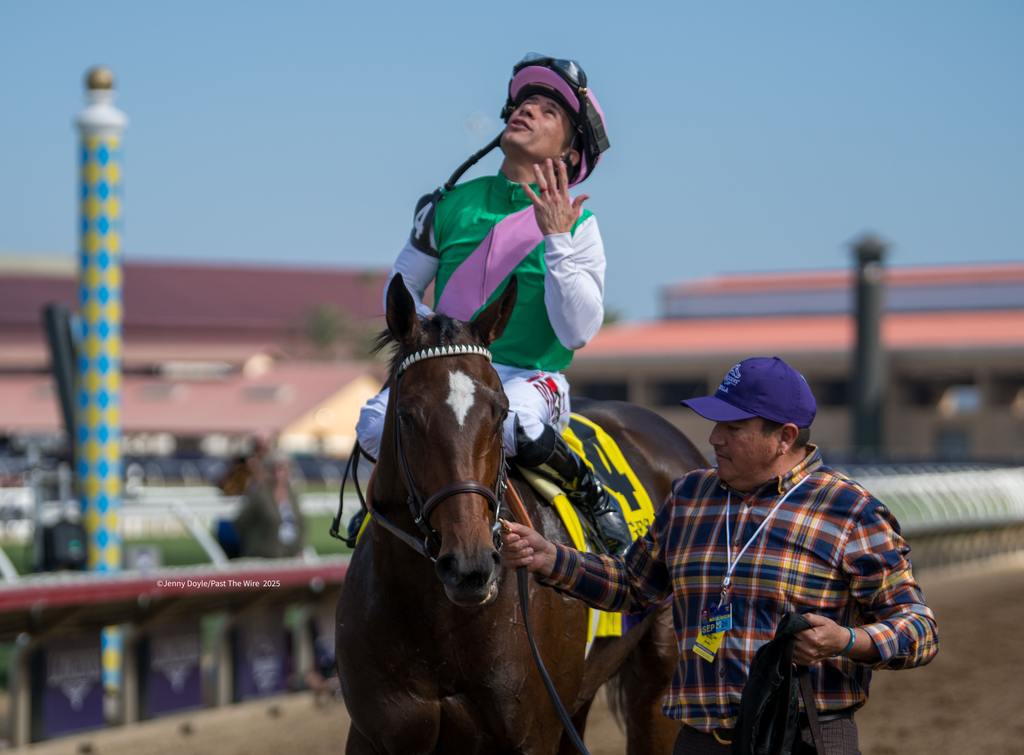
A contrast of horse racing regulations between Hong Kong, Japan and the United States
For a long time I have heard how Japan and Hong Kong Racing gets things right. While I peripherally knew they had strict rules I was unaware of many particulars. I remember when Umberto Rispoli first came to the US to ride he told me how riders were quarantined on race day and even prior to race day in Hong Kong and were not even allowed to use their cell phones. He relayed a story about how he had a problem with a social media account dedicated to him that he did not even run or post on. A wee bit different than things here. The other day I watched a horse in California, a stricter jurisdiction than many here in the states return after a win. the trainer met the jockey who he handed a cell phone and the jockey began to talk. The horse had not even made it to the winners’ circle yet not had the rider dismounted. I figured this was as good a time as any to delve a bit into the differences and I chose the Hong Kong Jockey Club, (HKJC), the Japan Racing Association, (JPA), and our own HISA. I almost included some others but I am glad I didn’t. What you’ll see here is the cliff notes version of what turned out to be a monumental task. I could have written a book on the differences. Instead I picked some glaring examples and ones I thought might resonate with a lot of you.
I. Introduction: Three Systems, Three Realities
When you’ve been around racing long enough, you learn one simple truth: the rules only matter if the people making them know what they’re doing. Hong Kong, Japan, and the United States all say they’re chasing integrity, fairness, and safety. But once you peel back the PR language, you find three very different ways of running this sport.
Hong Kong and Japan operate like racing fortresses — centralized, disciplined, one voice, one rulebook, no ambiguity. The U.S., through HISA, is trying to evolve from fifty different fiefdoms into one federal structure, but doing that in America means lawyers, courts, challenges, and growing pains the Asian jurisdictions never had to deal with. That’s the real dividing line: centralized authority versus constitutional gymnastics.
II. Governance: Who’s Actually in Charge?
The Asian Model: One Boss, No Confusion
I always say put too many chefs in the kitchen and the soup will be salty.
Hong Kong’s Jockey Club and the Japan Racing Association run racing the way a top-level operation should: one governing body, one set of rules, and an unbroken line between the regulators, the wagering system, and the product on the racetrack.
In Hong Kong, the Jockey Club runs everything — racing, betting, lotteries — and they use the revenue to protect integrity. Owning a horse there is a privilege, not a right, and the scrutiny is real. Japan is the same: government-funded, government-backed, and unapologetically strict. You don’t just show up to train or ride; you sit down with stewards, agree to their rules, and understand you’re operating in their arena. Participating in horse racing should be a privilege in my view. The horses deserve that respect and protection.
Both systems are efficient, coordinated, and built to last.
The U.S. Model: HISA and Federal Growing Pains
HISA was designed to fix an outdated patchwork of state rules that made uniformity impossible. And on paper, it does move racing closer to consistency — one national rulebook, one anti-doping program, one safety standard. But unlike Hong Kong or Japan, HISA operates under a federal framework that’s now tied up in constitutional challenges. Sadly this is just the beginning.
Opponents argue it gives a private corporation too much regulatory authority. The Supreme Court already bounced it back to the Sixth Circuit. That uncertainty creates instability the Asian models don’t deal with. This doesn’t even tough on something I stated earlier,
the rules only matter if the people making them know what they’re doing.
With HISA many in the industry question the rules, specifically the fairness and practicality and whether they are for optics or safety and regulation. Then we have the inconsistencies in the dispositions and handling of similar violations of these rules.
Bottom line: Hong Kong and Japan have authority locked down. The U.S. is still trying to secure the foundation.
III. Medication Control: Three Philosophies, Same Goal
Medication rules tell you how serious a jurisdiction is about integrity.
Japan: Uncompromising Clarity
Japan divides substances into “Prohibited” and “Restricted,” and the stand-down times are absolute. Ten days for most prohibited drugs. Five for certain sedatives. Zero tolerance for anabolic steroids, period. No wiggle room. No ambiguity. Trainers know exactly what they’re dealing with.
HISA: Consistency, but Still Finding Its Footing
Before HISA, U.S. medication rules were a roulette wheel depending on the state. Now everything runs through HIWU with uniform therapeutic rules, which is an improvement. But implementation hasn’t caught up to the ambition. There’s still confusion, slow and inconsistent rulings, and too many gray areas where trainers guess instead of know. This is not how you want to break from the gate, but I’d have to call this a stumbled at the start.
The Technical Barrier Nobody Talks About
Here’s the sleeper issue: Japan and the U.S. use the 99th percentile when calculating drug withdrawal times. Europe and Australia use 95%.
That tiny statistical gap creates a major competitive barrier. A horse cleared in Australia might test positive under U.S. or Japanese standards simply because the math is different. It’s a hidden roadblock to true international harmonization.
IV. Riding Rules: Two Views of the Same Tool
HISA: Count the Strikes
The U.S. uses strict numerical limits for whip usage — go over the number, you pay. Go way over, your horse can be disqualified from the purse money. It’s rigid, quantifiable, and meant to protect “integrity” as much as welfare, but does it and was it needed? First, jockeys will argue the new crops do not cause any injury like welts or and bleeding or significant pain. Most claim the crop is often needed to correct a horse and potentially for safety reasons. It is difficult to argue with that from a couch or never having ridden a race. Was this just for optics? This is a legitimate question if you understand the stewards at all US tracks have always had the authority to call any jockey in for misusing or excessively using the crop, they simply had to do their job. Instead we have a controversial rule that generates revenue, but doesn’t appear to protect the horses anymore than they were prior to the crop strike count.
Hong Kong: No Counting, Just Common Sense
Hong Kong takes the opposite view. They don’t make a jockey count strikes because they believe it distracts from race riding and safety. Instead they regulate the manner of use — no consecutive strikes before the 100-meter mark, no hitting forward of the saddle, no shoulder-high swings, no whipping a horse who’s done running.
Penalties are fines and suspensions, but never disqualification. Whip misuse there is a rider-conduct issue, not a corruption of the race outcome.
That’s the philosophical divide:
Is whip use a fairness issue (HISA) or a welfare optics issue (HKJC)?
V. Enforcement: Slow Due Process vs. Swift Stewardship
HISA: Built by Lawyers, Run with Paperwork
In the U.S., everything goes through a formal process — hearings, evidence rules, internal appeals, FTC oversight, and often federal court. It’s designed to protect due process, but the trade-off is speed. Nothing happens quickly.
Hong Kong & Japan: Quick, Clear, Final
The Asian systems handle discipline internally. Stewards act, penalties land, and the case moves on. Efficiency beats litigation every time.
This is why they appear more stable: less courtroom, more stewardship.
VI. Wagering Integrity: The Big Advantage Nobody Can Replicate
Hong Kong has a structural advantage the U.S. can’t match: they regulate both the racing and the betting. That means they monitor every legal wager, see patterns in real time, and work hand-in-hand with agencies like ICAC to shut down organized crime and illegal betting syndicates.
The U.S. wagering landscape is fragmented — ADWs, tracks, tote companies, state rules, and no centralized betting regulation. HISA doesn’t touch wagering integrity, which leaves a massive hole in the regulatory net. CAW’s are primarily regulated by the high volume betting outlets they wager through and who profits off their handle.
This is where Hong Kong is simply ahead of everyone.
VII. Conclusion: Three Models, Three Outcomes
If you want a snapshot of global racing governance, here it is:
- Hong Kong gets commercial integrity and operational efficiency right.
- Japan gets medication clarity and scientific rigor right.
- The U.S. gets national uniformity and due process right but only in theory not practicality — but still hasn’t locked in legal stability or wagering oversight.
Real harmonization won’t happen until:
- HISA survives constitutional scrutiny,
- the world agrees on a uniform withdrawal-calculation standard, and
- racing decides whether whip rules are about fairness or optics.
Different models, different strengths, different blind spots — but the takeaway is simple:
Some jurisdictions already built systems that work. The U.S. is trying to catch up, and whether it succeeds depends entirely on whether stability arrives before the next crisis does.
When you strip all the legalese, acronyms, and white papers away, this really comes down to who actually has the game under control and who’s still pretending they do. Hong Kong and Japan run tight, centralized ships where the rules are clear, the timelines are defined, the penalties are swift, and the betting markets are monitored like they actually matter to the integrity of the sport—because they do. You may not like every part of how they do it, but you don’t lie awake wondering who’s really in charge or whether some illegal offshore book is running ahead of the regulators. Over there, ownership is a privilege, not a participation trophy, and the stewards don’t need five layers of appeals and a federal agency to tell them what’s obvious to anyone with a set of eyes and a racing form.
Here in the US, we finally tried to drag a fractured, state-by-state mess into something that looks like a modern regulatory framework with HISA, and on paper that’s a step in the right direction. National rules, uniform medication standards, structured due process—those are all things we should have had a long time ago. But until HISA survives constitutional scrutiny, streamlines how it enforces what it writes, and finds a way to deal with wagering integrity with the same seriousness as horse and rider safety, we’re playing catch-up against jurisdictions that already solved a lot of this years ago. If we want to be taken seriously on the global stage, we’re going to have to pick a lane: either we build something as stable, fast, and decisive as the Asian models, or we keep tripping over our own courts, committees, and compromises while everyone else quietly gets it right.




